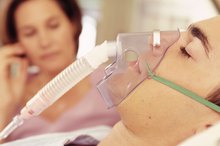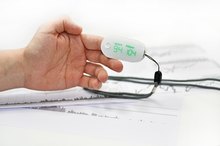Normal Oxygen Saturation for Children
Oxygen saturation is a clinical measurement that determines what percentage of a patient's red blood cells are saturated with oxygen after passing through the lungs. It is a result that reflects not only how well a patient's lungs are working but also how effectively oxygen is being delivered to all parts of the body. In a healthy child breathing room air, the oxygen saturation levels will be between 96 and 98 percent. Falling levels of oxygen saturation are concerning to physicians and may require intervention.
Significance
Oxygen saturation is an accurate measurement that reflects multiple aspects of a child's cardiovascular health 1. Monitoring the percent of red blood cells saturated with oxygen tells a physician how well a child is breathing, how efficiently the oxygen is being distributed to the body and how well oxygen is unloaded from red blood cells at its destination. A disruption in any of these processes will decrease the child's oxygen saturation and can necessitate therapeutic intervention.
Function
Causes of Low Blood Oxygen Levels
Learn More
Oxygen saturation sensing in a healthy child breathing room air will reveal a saturation rate between 96 and 98 percent. This is the normal range for a healthy adult as well. A disruption in oxygen metabolism can cause saturation levels to drop below 95 percent, at which point a physician might order intervention. Saturation levels that fall below 90 percent often require oxygen therapy, in which higher than normal amounts of oxygen are fed directly into the child's nose.
- Oxygen saturation sensing in a healthy child breathing room air will reveal a saturation rate between 96 and 98 percent.
Types
Typically, oxygen saturation is measured with a pulse oximeter. This is a painless clip that can be attached to the child on either a finger, toe or even ear lobe. It shines a red light through the sensed area and detects the extent of oxygen saturation in the blood in that region. This noninvasive measurement is often sufficient for monitoring purposes, but in more sensitive cases physicians may draw arterial blood from the child to directly measure oxygen levels.
- Typically, oxygen saturation is measured with a pulse oximeter.
- This noninvasive measurement is often sufficient for monitoring purposes, but in more sensitive cases physicians may draw arterial blood from the child to directly measure oxygen levels.
Benefits
Oxygen Saturation Exercise
Learn More
Constant monitoring of oxygen saturation is commonplace during hospital stays and at home for children with chronic pulmonary diseases, such as cystic fibrosis 1. Since measurement is simple, painless and cost-effective, it is a very efficient method for catching a change in oxygen delivery before severe consequences occur. Home-use pulse oximeters are widely available for home monitoring of oxygen saturation levels both at rest and during exercise 13.
Warning
In a hospital, falling oxygen levels are detected immediately and corrected in extreme situations with oxygen therapy. If you are monitoring your at-risk child at home, however, and you detect a drop in oxygen levels, consult your physician immediately. Efficient correction of low oxygen levels can help prevent long-term consequences and allow your child to lead a healthier life.
Related Articles
References
- American Thoracic Society: Oxygen Therapy for Children
- Pulse Oximeters Direct: Pediatric Pulse Oximeters
- McGill University, Office for Science and Society, "Under the Microscope: Blood"
- Collins JA, Rudenski A, Gibson J, Howard L, O'Driscoll R. Relating oxygen partial pressure, saturation and content: the haemoglobin-oxygen dissociation curve. Breathe (Sheff). 2015;11(3):194–201. doi: 10.1183/20734735.001415
- Gossman W, Alghoula F, Berim I. Anoxia (Hypoxic Hypoxia) [Updated 2019 Jul 11]. In: StatPearls [Internet]. Treasure Island (FL): StatPearls Publishing; 2019 Jan-.
- Giaccia AJ, Simon MC, Johnson R. The biology of hypoxia: the role of oxygen sensing in development, normal function, and disease. Genes Dev. 2004;18(18):2183–2194. doi: 10.1101/gad.1243304
- Leach RM, Treacher DF. Oxygen transport-2. Tissue hypoxia. BMJ. 1998;317(7169):1370–1373. doi: 10.1136/bmj.317.7169.1370
- Hafen BB, Sharma S. Oxygen Saturation. [Updated 2019 Jun 2]. In: StatPearls Treasure Island (FL): StatPearls Publishing. 2019 Jan.
Writer Bio
Erik Andrews began scientific and medical writing in 2004. His work as a second author on a research article appeared in the journal "Genetics" in 2005. His areas of expertise are the natural sciences, medical education and physical fitness. He earned a Master of Science in chemistry and a Bachelor of Arts in biochemistry, both from the University of Pennsylvania.









